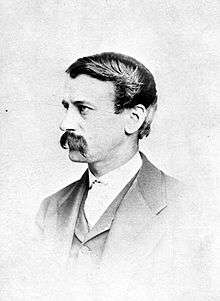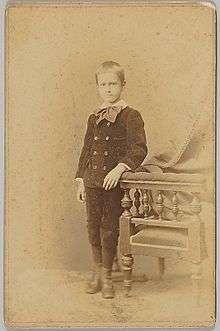Maitland Armstrong

David Maitland Armstrong (April 15, 1836[1] – May 26, 1918) was Charge d'Affaires to the Papal States (1869), American Consul in Rome (1869–71), and Consul General in Rome (1871–73).[2] He was also an important stained-glass artist.[3]
Early life

Armstrong was born in Danskammer, Newburgh, New York in 1836 and educated at Trinity College, Hartford, Connecticut from 1854.[4] He was the youngest of four sons of Edward Armstrong (1800–1840), a prominent local farmer, and his wife, Sarah Hartley Ward (1801–1853) of Charleston, South Carolina.[5] Edward Armstrong added to the land already acquired by his father, until eventually he owned farms extending along a nearly two mile frontage of the Hudson River, and built a substantial house, the Edward Armstrong Mansion, now demolished, but with its huge Ionic columns on display in the grounds of the Storm King Art Center.[6]
His grandfather was Colonel William Armstrong, who came from Scotland with the British Army during the American Revolution.[7] His grandfather was present at the Battle of Yorktown, as was his wife's grandfather, Colonel Nicholas Fish, but he was on the winning side. In his memoirs, Maitland wonders if they ever met.[8]
His brothers were William Henry, Gouverneur, and John Armstrong. William Henry Armstrong (and his family) lived at Gomez Mill House from 1835 to 1904, the earliest surviving Jewish residence in the US, and now a museum, with several of Maitland Armstrong's artworks on display.[7][9]
In the autumn of 1858, Maitland Armstrong sailed to Italy, arriving just before the new year, where he spent months touring the country and making illustrations of the scenery and ancient monuments.[3]
Life in Italy

Armstrong was American Consul in Rome, 1869–71, Charge d'Affaires to the Papal States 1869 and Consul General in Rome 1871–73.[2] Armstrong's duties required him to make the acquaintance of as many Americans in Rome as possible, which he undertook with enthusiasm. Many were artists who became lifelong friends, such as Elihu Veder, Frederick Crowninshield, Charles C. Coleman, George Yewell, William Gedney Bunce, George Inness and George Healy. He also met Augustus Saint-Gaudens.[3]
1878 Paris Exposition Universelle
Armstrong was appointed Director of American Fine Arts at the 1878 Paris Exposition Universelle. He had a great deal of difficulty negotiating which pictures were to be shown, as the committee making recommendations preferred only well-established artists, and Armstrong wished to include young and less-established painters such as Winslow Homer and John La Farge. When it came to the hang, works were positioned according to merit with the best "on the line" and lesser works nearer the ceiling. This engendered resentment from established artists who found their work placed further up the wall.[10] At this time, former U.S. President Ulysses S. Grant was on a long world tour, and Armstrong met him several times socially and to show him around the Exposition.[11] Armstrong was awarded the Légion d'honneur for his work on the Exposition.[12]
Painting
Armstrong's paintings were mainly of landscapes and picturesque country scenes.
 Venice. Oil on board, 1872. Private collection.
Venice. Oil on board, 1872. Private collection.%2C_Maitland_Armstrong_1877.jpg) The Bar, Bar Harbor, Mt. Desert (Maine). Oil on canvas, 1877. Reworked 1883. Milwaukee Art Museum.[13]
The Bar, Bar Harbor, Mt. Desert (Maine). Oil on canvas, 1877. Reworked 1883. Milwaukee Art Museum.[13]
 Store on the Erie Canal. 1881. Possibly painted from memory of Armstrong's trip along the canal in 1880.[15]
Store on the Erie Canal. 1881. Possibly painted from memory of Armstrong's trip along the canal in 1880.[15]
Stained glass
From the 1880s, Armstrong worked with his friends Louis C. Tiffany and John La Farge. In 1887 he formed his own firm, Maitland Armstrong and Co., of New York.[3]
Later, his daughter Helen Maitland Armstrong (1869–1948)[16] joined him in the business and she became an important stained-glass artist in her own right. Works created included important installations at the Appellate Court Building in New York, Vanderbilt's All Souls Church in Asheville, and the Church of the Ascension in New York.[17]
Armstrong was one of the foremost exponents of American-style opalescent stained glass during the American Renaissance or Gilded Age.[3] He had already been influenced by classical art even before he arrived in Italy. One of his professors at college upbraided him for choosing to paint a copy of a Venus Rising From The Sea rather than studying William Whewell's Elements of Morality as he should have done.[18]
Family

Armstrong married Helen Neilson, a descendant of Peter Stuyvesant and a niece of Hamilton Fish. They had seven children, six of whom survived to adulthood. Helen Maitland Armstrong (1869–1948) followed in her father's footsteps in the family business. Her sister Margaret Neilson Armstrong (1867–1944)[19] became a noted book designer and later novelist and biographer, while their brother Hamilton (Ham) Fish Armstrong, was editor of the influential U.S. foreign policy journal Foreign Affairs from 1928 to 1972.[20] The other children were Marion Howard Armstrong (1880-1957), who married Alfred Edey, Noel Maitland Armstrong (1882-1938), and Edward Maitland Armstrong (1874-1915).
He died at his home at 58 West Tenth Street, New York,[21] which is now sometimes known as the D. Maitland Armstrong House.[22] Armstrong purchased number 58 in 1890 and refurbished it, adding decorative flourishes in leaded stained glass and wrought iron. The Tenth Street Studio Building (now demolished), was built at number 51 in 1858 for artists, and became the centre of artistic life in New York for the rest of that century. The New York Times notes that "For some people, West 10th Street between Fifth and Sixth Avenues is the most beautiful block in New York City." [23]
References
- ↑ Armstrong, Maitland. Margaret Armstrong (Ed.) (1920) Day before Yesterday: Reminiscences of a Varied Life. New York: Scribner, p. 157.
- 1 2 Armstrong, D. Maitland (David Maitland), 1836-1918 Archives Directory for the History of Collecting in America, The Frick Collection, 2014. Retrieved 30 June 2014.
- 1 2 3 4 5 Jones, Robert O. "Italian Inspiration in Maitland Armstrong's Stained Glass and Mosaics" in Irma B. Jaffe (Ed.) (1992). The Italian Presence in American Art, 1860-1920. New York & Rome: Fordham University Press & Instituto Della Enciclopedia Italiana. pp. 97–104. ISBN 978-0-8232-1342-9.
- ↑ Armstrong, 1920, p. 88.
- ↑ Wingfield, Valerie. "Armstrong – Neilson Family Papers, 1755–1930" (PDF). NYPL. Retrieved 7 July 2014.
- ↑ "A brief history of Roseton and Danskammer Point, NY". Brickcollecting.com. Retrieved 7 July 2014.
- 1 2 "The Armstrong Family – Residents from 1835–1904". Gomez.org. Retrieved 7 July 2014.
- ↑ Armstrong, 1920, p. 5.
- ↑ "Gomez Mill House Museum". Hudsonrivervalley.com. Retrieved 7 July 2014.
- ↑ Armstrong, 1920, pp. 266-270.
- 1 2 Armstrong, 1920, p. 278.
- ↑ Armstrong, 1920, p. 276.
- ↑ http://collection.mam.org/details.php?id=18392
- ↑ Armstrong, 1920, p. 326.
- ↑ Armstrong, 1920, p. 299.
- ↑ The Collection Online Metropolitan Museum of Art, 2014. Retrieved 6 July 2014.
- ↑ D. Maitland Armstrong: American Stained Glass Master Stained Glass Association of America. Retrieved 1 July 2014.
- ↑ Armstrong, 1920, pp. 90-91.
- ↑ http://thepassingtramp.blogspot.co.uk/2012/02/art-of-murder-murder-in-stained-glass.html
- ↑ Had I But Known Authors #2: Margaret Armstrong, HIBK Patrician The Passing Tramp, 28 January 2012. Retrieved 6 July 2014.
- ↑ "MAITLAND ARMSTRONG, ARTIST, DIES AT 82; Widely Known for His Stained Glass Designs--Was Once Consul General at Rome.". New York Times. Retrieved 7 July 2014.
- ↑ "The D. Maitland Armstrong House - No. 58 W. 10th Street". Daytonian in Manhattan. Retrieved 7 July 2014.
- ↑ Gray, Christopher (6 July 1997). "Street of Lush Gardens and Architectural Coherence". New York Times. Retrieved 7 July 2014.
Further reading
- Jones, Robert O. (1999) D. Maitland Armstrong: American Stained Glass Master. Tallahassee: Sentry Press. ISBN 9781889574165
External links
| Wikimedia Commons has media related to Maitland Armstrong. |